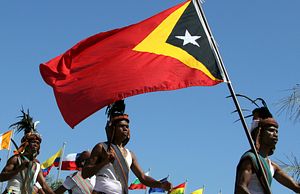Twenty-years ago, Timor-Leste was tipped into the abyss. A UN-backed referendum on August 30th, 1999 – the 20th anniversary of which was commemorated last week – paved the way to nationhood with voters overwhelmingly favoring independence, but a bloody rampage by pro-Jakarta militias resulted in over 1,000 dead along with massive displacement.
Australian-led UN peacekeepers landed weeks later and helped restore order. And independence finally followed on May 20, 2002, with the election of resistance leader Xanana Gusmao as president, who retains a cult-like status in the country even today.
But Timor-Leste has struggled with democracy since. The UN redeployed in 2006 after people fled their homes amid factional fighting, and reinforcements followed in early 2008 when President Jose Ramos-Horta was critically wounded in an assassination attempt.
Peacekeeping provided an initial economic backbone. But since that ended in 2012, Timor-Leste’s GDP has been cut in half to less than $3 billion per World Bank figures, and the official unemployment rate belies the extent of the problem in this area given the youthful population the country has. While hopes for democracy in Timor-Leste might be brighter than in most Southeast Asian countries these days, economically, it remains the subregion’s poorest nation.
The domestic economic challenges for Timor-Leste acknowledged by President Francisco Guterres himself, who stated bluntly, during a speech to commemorate the independence vote, that 60 percent of East Timorese are now of working age, yet only 19 percent had jobs.
Of them, 8 percent were employed in the public and private sectors, while the rest worked in the informal market in an economy which has been in recession since 2017.
“We know that the informal sector offers its workers no security because it’s based on low wages, no contracts, irregular employment and poor working conditions. This situation must change,” he said rather candidly.
Timor-Leste’s often complicated relations with regional powers like Australia, China and Indonesia has not helped. Anticipated foreign aid, revenue from oil and gas, and the construction of infrastructure projects have been disappointing thus far.
But that is changing, or so the country hopes. Timor-Leste is pushing for membership to the Association of South East Asian Nations (ASEAN) and its long-running disputes with Australia over sea boundaries and much needed revenue from offshore oil and gas claims appear to be over.
A settlement between the neighbors over their shared maritime border will entitle Timor-Leste to a much bigger share of the Greater Sunrise oil and gas development, even though uncertainty remains about how this will play out. Australia is also set to play a role in other areas, including bolstering high-speed Internet traffic and refurbishing a naval base.
Meanwhile China, like elsewhere in the region, is also investing heavily, including by financing a deep water port, an electricity grid, a four lane highway and China Railway Construction Corp has signed a multi-million dollar contract with state-owned Timor Gap to help run an LNG plant.
But the scars of 1999 run deep. True reconciliation has proven elusive, and Timor-Leste’s politics also still continues to surround key individuals rather than institutions. Nonetheless, the hope is that Timor-Leste will be able to move further away from its dreadful past and closer to the brighter future that its advocates hope for.
Luke Hunt can be followed on Twitter @lukeanthonyhunt.

































